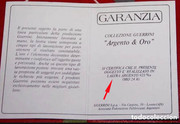On the back of the wooden frame, it is marked CAO, another image, and 925 again. My understanding is that CAO stands for the Cyprus Assay Office, and the image is the Cypriot national mark. So therein lies the question: Why does this piece have different national markings on it? Perhaps someone from Cyprus bought the icon in Italy (maybe Loreto), brought it back, and had someone in Cyprus frame it? I appreciate the reaffirmation of the silver content by both sets of marks, but this just seems a little strange to me. And yes, I bought it in the US, so this piece has definitely been around.
On top of that, the icon seems to be plated with something that appears to be chipping away at the edges. There're two levels of silver hues on the surface, with one a little darker than the other. Given the markings, I assume it to be maybe rhodium plating to prevent against tarnish. But in the back of my mind, I'm also questioning whether this could be silver-plated, and marketed as 925 silver.
Peering through the narrow opening between the icon and the frame, which I believe is held together by resin, the icon itself appears to be solid, i.e. not repousse (too thick), but either molded or sculpted. So this is a good chunk of silver, if really sterling. I know we're not supposed to discuss prices on this forum, but I'll just say that what I paid is not commensurate with the silver value (if real). That said, I knew I was taking a risk by purchasing it, but would like some expert opinions on the genuineness and (bi-national) provenance of the piece.
The images are below. Thank you in advance.







